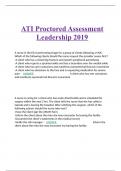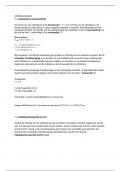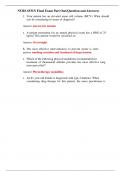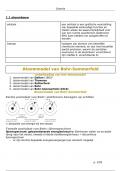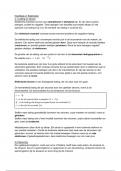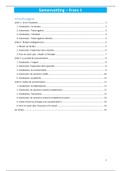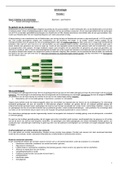Aangeboren immuniteit
Drie lijnen van verdediging tegen infectie
Eerste lijn
Huid
Mucous membranes
Secretions of skin and mucous membranes
Tweede lijn: aangeboren/ natuurlijke afweer
Phagocytic white blood cells
Antimicrobial proteins
Inflammatory respons
Derde lijn: adaptieve/ verworven afweer
Lymfocyten
Antilichamen
Barrières die voorkomen dat pathogenen de epitheliale laag passeren en weefsels
koloniseren
Mechanisch
Epitheliale cellen aaneengesloten door tight junctions
Longitudinale flow van lucht of vloeistof
Beweging van mucus door cilia (trilharen)
Tranen
Chemisch
Vetzuren
Lage pH
Enzymen (ook in tranen)
Antibacteriële peptiden
Microbiologisch
Normale flora (bacteriën)
Tweede en derde lijn van verdediging – aangeboren en verworven immuunsysteem –
Tweede lijn
Basophilen, eosinophilen, dindritische cellen, NK cellen, macrophagen
Derde lijn
T cellen -> CD4+ & CD8+, B cellen -> antilichamen
Epitheliale weefsels
Microlaesi -> kleine “opening“ waardoor pathogenen binnen kunnen komen
Hoe dringen pathogenen het menselijk lichaam in?
Mond en ademhalingsstelsel
Inhalatie, sporen
Gastrointestinale tract
Contaminated water or food
Voortplantingsorganen
Boodschap: pathogenen kunnen op heel veel verschillende manieren binnenkomen
,Op welke manieren zijn pathogenen schadelijk voor het menselijk lichaam? Mentimeter
Hoe beschadigen pathogenen het menselijk lichaam?
Directe mechanismen die leiden tot weefselschade
Exotoxine productie
Endotoxines
Direct cytopathisch effect
Indirecte mechanismen die leiden tot weefselschade -> immuunrespons zorgt voor schade
aan eigen lichaam
Immuuncomplexen
Anti-host antibody
Cell-mediated immunity
Staan ziektes bij, hoef je niet direct te weten
Pathogenen zijn er in verschillende “smaken”
Localisatie
Locatie van pathogenen is verschillend
Luminale pathogenen (elke soort)
Cytoplasmatische pathogenen (virussen)
Endosomale pathogenen (parasieten/ bacterien)
Extracellulaire pathogenen (bacterien/ schimmels)
Voor de bestrijding zijn verschillende afweerreacties nodig
Uni- of multicellulair
Toxines
Infectie mobiliseert gespecialiseerde natuurlijk afweercellen voor bestrijding van
hoofdklassen van pathogenen
Natuurlijke killer (NK) cellen -> virussen
Doden virus-geïnfecteerde cellen (en kankercellen)
Macrofagen -> endosomale bacteriën
Fagocyteren pathogenen (bijv bacteriën) en breken die intracellulair af in het
endosoom met enzymen uit de lysosomen
Eosinofiele – en basofiele granulocyten -> multicellulaire parasieten
Bestrijden multicellulaire parasieten door degranulatie van toxische moleculen
Neutrofiele granulocyten -> extracellulaire bacteriën/ schimmels
Professionele killers van extracellulaire bacteriën & schimmels
NET = neutrophil extracellulair traps
Aangeboren en verworven immuniteit
Aangeboren immuunsysteem: activiteit binnen 0-4 uur
Infection -> herkenning door preformed, non specific and broadly specific
effectors -> removal of infectious agent
Early induced innate response: 4-96 uur
, Adaptive immune response: > 96 uur
Herkenning door B & T cellen -> differentieren tot effector cellen -> removal
of infectious agent
Aangeboren verdediging
Antimicrobiële peptiden
Bijv. Beta-defensine-5 in darm
Hoe herkennen aangeboren immuuncellen pathogenen? Menti
Pattern Recognition Receptors (PRR)
Door Charley Janeway
PRR zijn receptoren van aangeboren immuniteit
Herkennen archetypische structuren die klasse van pathogenen klassificeren
(bacterien, schimmels, virussen, multicellulaire parasieten)
Pathogen-Associated Molecular Patterns (PAMPs)
Binden aan receptoren op macrofagen
Om herkenning te voorkomen, kunnen pathogenen deze structuren niet
makkelijk muteren zonder hun integriteit te verliezen
PRR typen zijn
Signalerende typen
Membrane Toll-like receptoren
Cytoplasmatische receptoren
Endocyterende typen
Mannose-receptoren
Etc…
De meeste cellen brengen receptoren voor fagocytose tot expressie
“Pattern Recognition Receptors” voor fagocytose
Opname voor afbraak van pathogeen (phagolysosomen)
Tijdens inflammatoire respons worden cytokines en chemokines geactiveerd
De meeste cellen brengen meerdere soorten PRR’s tot expressie
Directe herkenning van Pathogen-Associated molecular patterns door Toll-like receptoren
Geen TLR’s? -> veel infecties!
Enkele Pattern Recognition Receptoren en hun liganden
Tollike-receptoren op buitenmembraan om structuren van extracellulaire
pathogenen te herkennen
Ook endosomale pathogenen herkend door Tol-like receptoren op binnenmembraan
Cytoplasmatische Pattern Recognition receptoren aanwezig
, Extracellulaire bacteriën worden herkend door verschillende onderdelen in hun celwand
Onderscheid herkenning gram positief – gram negatief
Gram negatief: Lipopolysaccharide (LPS) in celwand
Pattern Recognition Receptors voor anti-bacteriële cytokine productie
Bacterial proteoglycans can be recognized by TLR’s at the cell’s surface or by NOD
proteins in the cytosol. Both lead to the activation of the transcription factor NFkB and the
expression of pro-inflammatory genes -> inflammation
Pattern Recognition Receptors voor anti-bacteriële cytokine productie
Double stranded viral RNA’s can be recognized by TLR’s in endosomes and by RIG-1
or MDA-5 in the cytosol to induce the expression of interferons -> inflammation
Cel oppervlakte receptoren (PRR’s) bindt PAMP -> signaal transductie -> productie TNF-
alpha (antibacterieel)
Endosomale en cytoplasmatische receptoren binden .. -> signaal transductie -> antiviraal
Wat zijn chemokines en wat doen ze? Menti
Chemokines: zorgen voor migratie van effector cellen naar haard van infectie
Veel soorten
CXCL8 belangrijk tijdens anti bacteriele respons
Trekt neutrofielen aan
CXCL10 chemokienen trekken NK cellen aan, die virus geïnfecteerde cellen opruimen
Aangeboren verdidiging tegen bacterien
Immigratie van immuuncellen
Bacteria tigger macrophages to release cytokines…
…
…
Activatie van TLR4 op macrofaag door lipopolysaccharide (LPS) afkomstig van gram-
negatieve bacterie leidt tot mobilisatie van neutrofielen uit het bloed
Anti-bacteriële immuunrespons
Cytokines: TNF-alpha
Chemokines: CXCL8
Zorgt dat cytokines op goede plek komt
Cytokines: Activatie NK cellen
Antivirale immuunrespons
IFN-alpha, IFN-beta -> NK cellen
Vroeg in immuunrespons gemaakt
Stuk later komt verworven immuunsysteem op gang (T cellen)
Infectie mobiliseert gespecialiseerde natuurlijk afweercellen voor bestrijding van
hoofdklassen van pathogenen
Drie lijnen van verdediging tegen infectie
Eerste lijn
Huid
Mucous membranes
Secretions of skin and mucous membranes
Tweede lijn: aangeboren/ natuurlijke afweer
Phagocytic white blood cells
Antimicrobial proteins
Inflammatory respons
Derde lijn: adaptieve/ verworven afweer
Lymfocyten
Antilichamen
Barrières die voorkomen dat pathogenen de epitheliale laag passeren en weefsels
koloniseren
Mechanisch
Epitheliale cellen aaneengesloten door tight junctions
Longitudinale flow van lucht of vloeistof
Beweging van mucus door cilia (trilharen)
Tranen
Chemisch
Vetzuren
Lage pH
Enzymen (ook in tranen)
Antibacteriële peptiden
Microbiologisch
Normale flora (bacteriën)
Tweede en derde lijn van verdediging – aangeboren en verworven immuunsysteem –
Tweede lijn
Basophilen, eosinophilen, dindritische cellen, NK cellen, macrophagen
Derde lijn
T cellen -> CD4+ & CD8+, B cellen -> antilichamen
Epitheliale weefsels
Microlaesi -> kleine “opening“ waardoor pathogenen binnen kunnen komen
Hoe dringen pathogenen het menselijk lichaam in?
Mond en ademhalingsstelsel
Inhalatie, sporen
Gastrointestinale tract
Contaminated water or food
Voortplantingsorganen
Boodschap: pathogenen kunnen op heel veel verschillende manieren binnenkomen
,Op welke manieren zijn pathogenen schadelijk voor het menselijk lichaam? Mentimeter
Hoe beschadigen pathogenen het menselijk lichaam?
Directe mechanismen die leiden tot weefselschade
Exotoxine productie
Endotoxines
Direct cytopathisch effect
Indirecte mechanismen die leiden tot weefselschade -> immuunrespons zorgt voor schade
aan eigen lichaam
Immuuncomplexen
Anti-host antibody
Cell-mediated immunity
Staan ziektes bij, hoef je niet direct te weten
Pathogenen zijn er in verschillende “smaken”
Localisatie
Locatie van pathogenen is verschillend
Luminale pathogenen (elke soort)
Cytoplasmatische pathogenen (virussen)
Endosomale pathogenen (parasieten/ bacterien)
Extracellulaire pathogenen (bacterien/ schimmels)
Voor de bestrijding zijn verschillende afweerreacties nodig
Uni- of multicellulair
Toxines
Infectie mobiliseert gespecialiseerde natuurlijk afweercellen voor bestrijding van
hoofdklassen van pathogenen
Natuurlijke killer (NK) cellen -> virussen
Doden virus-geïnfecteerde cellen (en kankercellen)
Macrofagen -> endosomale bacteriën
Fagocyteren pathogenen (bijv bacteriën) en breken die intracellulair af in het
endosoom met enzymen uit de lysosomen
Eosinofiele – en basofiele granulocyten -> multicellulaire parasieten
Bestrijden multicellulaire parasieten door degranulatie van toxische moleculen
Neutrofiele granulocyten -> extracellulaire bacteriën/ schimmels
Professionele killers van extracellulaire bacteriën & schimmels
NET = neutrophil extracellulair traps
Aangeboren en verworven immuniteit
Aangeboren immuunsysteem: activiteit binnen 0-4 uur
Infection -> herkenning door preformed, non specific and broadly specific
effectors -> removal of infectious agent
Early induced innate response: 4-96 uur
, Adaptive immune response: > 96 uur
Herkenning door B & T cellen -> differentieren tot effector cellen -> removal
of infectious agent
Aangeboren verdediging
Antimicrobiële peptiden
Bijv. Beta-defensine-5 in darm
Hoe herkennen aangeboren immuuncellen pathogenen? Menti
Pattern Recognition Receptors (PRR)
Door Charley Janeway
PRR zijn receptoren van aangeboren immuniteit
Herkennen archetypische structuren die klasse van pathogenen klassificeren
(bacterien, schimmels, virussen, multicellulaire parasieten)
Pathogen-Associated Molecular Patterns (PAMPs)
Binden aan receptoren op macrofagen
Om herkenning te voorkomen, kunnen pathogenen deze structuren niet
makkelijk muteren zonder hun integriteit te verliezen
PRR typen zijn
Signalerende typen
Membrane Toll-like receptoren
Cytoplasmatische receptoren
Endocyterende typen
Mannose-receptoren
Etc…
De meeste cellen brengen receptoren voor fagocytose tot expressie
“Pattern Recognition Receptors” voor fagocytose
Opname voor afbraak van pathogeen (phagolysosomen)
Tijdens inflammatoire respons worden cytokines en chemokines geactiveerd
De meeste cellen brengen meerdere soorten PRR’s tot expressie
Directe herkenning van Pathogen-Associated molecular patterns door Toll-like receptoren
Geen TLR’s? -> veel infecties!
Enkele Pattern Recognition Receptoren en hun liganden
Tollike-receptoren op buitenmembraan om structuren van extracellulaire
pathogenen te herkennen
Ook endosomale pathogenen herkend door Tol-like receptoren op binnenmembraan
Cytoplasmatische Pattern Recognition receptoren aanwezig
, Extracellulaire bacteriën worden herkend door verschillende onderdelen in hun celwand
Onderscheid herkenning gram positief – gram negatief
Gram negatief: Lipopolysaccharide (LPS) in celwand
Pattern Recognition Receptors voor anti-bacteriële cytokine productie
Bacterial proteoglycans can be recognized by TLR’s at the cell’s surface or by NOD
proteins in the cytosol. Both lead to the activation of the transcription factor NFkB and the
expression of pro-inflammatory genes -> inflammation
Pattern Recognition Receptors voor anti-bacteriële cytokine productie
Double stranded viral RNA’s can be recognized by TLR’s in endosomes and by RIG-1
or MDA-5 in the cytosol to induce the expression of interferons -> inflammation
Cel oppervlakte receptoren (PRR’s) bindt PAMP -> signaal transductie -> productie TNF-
alpha (antibacterieel)
Endosomale en cytoplasmatische receptoren binden .. -> signaal transductie -> antiviraal
Wat zijn chemokines en wat doen ze? Menti
Chemokines: zorgen voor migratie van effector cellen naar haard van infectie
Veel soorten
CXCL8 belangrijk tijdens anti bacteriele respons
Trekt neutrofielen aan
CXCL10 chemokienen trekken NK cellen aan, die virus geïnfecteerde cellen opruimen
Aangeboren verdidiging tegen bacterien
Immigratie van immuuncellen
Bacteria tigger macrophages to release cytokines…
…
…
Activatie van TLR4 op macrofaag door lipopolysaccharide (LPS) afkomstig van gram-
negatieve bacterie leidt tot mobilisatie van neutrofielen uit het bloed
Anti-bacteriële immuunrespons
Cytokines: TNF-alpha
Chemokines: CXCL8
Zorgt dat cytokines op goede plek komt
Cytokines: Activatie NK cellen
Antivirale immuunrespons
IFN-alpha, IFN-beta -> NK cellen
Vroeg in immuunrespons gemaakt
Stuk later komt verworven immuunsysteem op gang (T cellen)
Infectie mobiliseert gespecialiseerde natuurlijk afweercellen voor bestrijding van
hoofdklassen van pathogenen

